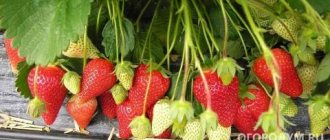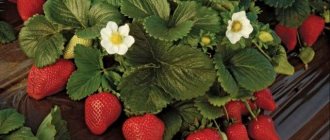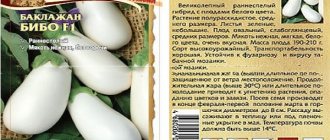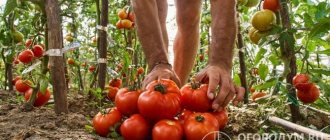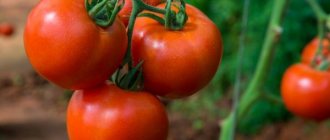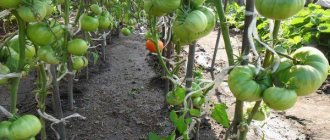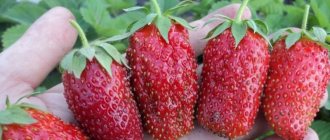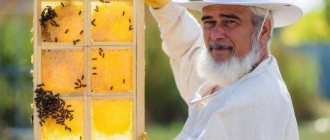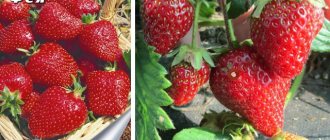The Festivalnaya strawberry was bred by crossing the Premier and Obilnaya varieties in 1954. The berry crop was included in the State Register in 1958. The plant has been zoned for cultivation in all regions of Russia, even in the Urals, Western and Eastern Siberia. “Festivalnaya” is one of the few varieties that continues to be valued among gardeners for a long time.
Description of the strawberry variety Festivalnaya
A brief botanical description of the strawberry variety is as follows: the bushes are compact, vigorous, well leafy. The variety has abundant upright foliage. The large leaves are matte and dark green in color. The surface of the leaf is wrinkled and ribbed.
Strawberry mustache is red. Their growth is intense and produces many rosettes, which can reach up to 30 pieces from one bush. One bush can have up to 15 peduncles, which are located at the level of the leaves or below; they are strong and thick, due to which they can bend under the weight of the berries (Figure 1).
Figure 1. Festival strawberry - a hybrid created by domestic breeders
The inflorescences contain several large white flowers. One strawberry bush can have 40-50 ovaries. Strawberry fruits are oval and slightly flattened. Their surface has longitudinal grooves on both sides. The berries are bright red, with a shiny, glossy surface. The fruit is easily separated from the stalk. Strawberries have juicy pulp of moderate density. This variety of berries is valued for its usefulness; it is a leader in vitamin C content.
Description and characteristics of the variety
Medium ripening variety. Depending on the region, the first berries will ripen from June to July. Due to the duration of fruiting, strawberries are harvested in several stages.
Note: The strawberry bush is tall, powerful, but at the same time compact. Clusters of berries are always clearly visible from under the leaves of the bush.
The peduncles, tendrils, and leaf petioles of this variety are thick and juicy. The variety has dark green leaves with clearly defined teeth along the edges. The berries have a scarlet glossy color and are often irregular in shape: round, conical, flattened or trapezoidal (Figure 2).
Figure 2. The fruits of the crop are large in size and juicy pulp
The first harvest of berries grows up to 35 cm, then begins to shrink. For this reason, the average weight of the fetus is considered to be 10 grams. The achenes of the fruit are not pressed into the skin and are located on the surface. The pulp is dense, juicy and rich red in color. Experts rated the taste of the berries as good.
Varietal advantages and disadvantages
Disease problems for this variety can only be confirmed by a few diseases, but such problems are extremely rare. The risk of disease can arise only if there is a complete lack of care for it or the cultivation of the crop falls on unfavorable weather. Such problems can be solved if they are recognized in time (Figure 3).
Figure 3. The main advantage of the variety is high yield
This fact is perhaps the only drawback of Festivalnaya strawberries. But the hybrid has many more advantages.
These include:
- The fruiting period of strawberries extends until late autumn, so you can collect several crops from one garden bed for your own consumption and sale.
- High yield of the variety and excellent commercial quality of the fruit. However, it should be borne in mind that the largest berries are harvested in the first wave of the harvest. Subsequently, the berries begin to become smaller.
- Undemandingness and ease of care are combined with immunity to pests and a large number of crop diseases, resistance to drought and frost.
- Bushes can be planted not only in the sun, but also in light shade. This arrangement will not affect the appearance and taste of the berries at all.
Russian gardeners had enough time to check the variety. Compatriots often speak positively about the Festival variety of strawberries, which means it deserves it.
Reviews from gardeners
Nikolai Viktorovich, Moscow, 53 years old.
I grew the festival one for a very long time and for a very long time. Then I refused due to reasons that I will describe a little later. For myself, I found out one main drawback and one huge plus. Of all the varieties I have ever grown, this is the most frost-hardy. I remember in 2002 there were terrible frosts, all the strawberries froze, but Festivalnaya survived the frosts, withdrew in the spring and gave a good harvest. But strawberries also have a significant drawback, which is why I stopped growing them. Very strongly affected by ticks. You can’t do without treatment, it will gobble up everything. If we didn't have ticks, it wouldn't have gone anywhere. And with this misfortune, growing this variety is quite problematic.
Natalya Yuryevna, Ryazan, 55 years old.
I read a lot of reviews about this strawberry online. Mostly negative. I want to dispel this myth. Yes, it has its drawbacks, but if you properly care for strawberries, then no problems should arise. All my adult life I have grown strawberries, including Festival strawberries. Drought, frost, bad weather, all for nothing at the Festival. Always had it with berries. From 20 m2, on average, I collect about 20 buckets (in one bucket there are about 6 kg of strawberries). And there was still a lot left in the beds for home use. They were always sold out quickly at the market, as the berries were sweet and large.
Victoria Alexandrovna, Tomsk, 43 years old.
Festivalnaya is an old, good variety. Before the tick appeared in our area, it was my favorite variety. Now I’ve given up growing it, because I won’t have any problems with this mite. If there is no mite, I advise you to grow it.
Landing technology
The preferred site for planting the Festival strawberry variety is a sunny place protected from the wind. It is also desirable that the bed be level and slightly raised, or with a slight slope, so that moisture does not stagnate at the roots.
Note: The crop is undemanding to soil and tolerates partial shade. The ideal soils are loams with a slightly acidic reaction and sandy loam rich in organic matter.
Planting is carried out in the spring, as soon as warm weather sets in, but in the southern regions planting can be carried out at the very beginning of spring. This early movement into the ground is due to the fact that the strawberries must have time to take root before the heat sets in. This is very important, since this variety does not respond well to heat and drought (Figure 4).
Other planting features include:
- The bushes are placed quite far from each other and in a checkerboard pattern. On average, the bush from the bush in the same row should be located at a distance of 60 cm.
- This arrangement of bushes will help avoid replanting plants for five years.
- After a certain period of time, the berry will become smaller and if the daughter rosettes do not take root, then the variety will degenerate.
- If there is not enough time to care for strawberries, then they are planted using the carpet method. Shallow furrows are made at a distance of 50 cm from each other, into which strawberry bushes are placed, maintaining a distance of up to 60 cm.
With the carpet planting method, festival strawberries quickly take over the entire garden bed. In one place with this method of planting, it can grow for up to 3-4 years.
Figure 4. Bush planting technology
The stages of the process of such planting: a handful of mature humus with one tablespoon of superphosphate is added to the hole and all this is mixed with soil, then completely filled with water. Only after the moisture has been absorbed do they begin to plant the strawberries so that the growing point is level with the soil surface. At the same time, water the bed abundantly and then mulch it.
Note: The main thing is not to bury the growing point of the strawberry, as this can lead to the death of the bush. But if planted too high in winter, the bush will crawl out of the ground under the influence of negative temperatures, which will lead to freezing.
Garden strawberries are planted in separate bushes. Seedlings are planted at a distance of 55-60 cm from the bush. Bushes are planted in nests: one in the middle, and around it 6 bushes, using the so-called carpet method.
In the first year, such seedlings do not bear fruit, but only produce tendrils that fill the space between the rows. The beginning of April and the beginning of September are recommended for planting Festival strawberries. Since this variety loves moist soil, summer planting is not recommended for it.
Preparing the site
The ideal soil for strawberries is sandy or loamy. The pH reaction is slightly acidic. The area for strawberries should be open and sunny with deep groundwater. Be sure to take care of wind protection.
Garden strawberries do not like strong winds. Preparatory activities include:
- Digging the earth to a depth of 0.25 m.
- Removing weeds and applying fertilizer.
The best fertilizer would be to mix mullein (6 kg), superphosphate (50 g), and potash fertilizer (20 g). The figures are given per 1 sq. m area. If you prepare the soil in this way, the strawberries will grow and bear fruit well.
Rules of care
The Festival strawberry variety has powerful bushes and tendrils. During the period of flower stalk formation, the berry needs regular watering. In order for the plant to establish a strong root system, it is necessary to remove the tendrils and peduncles in the first year of life.
Figure 5. The variety does not tolerate heat and drought, so the bed must be mulched
The variety loves moisture, so it needs regular watering. Particular attention should be paid to watering immediately after planting the bushes. It is recommended to water young strawberry bushes every two days. The watering rate per square meter is 9-10 liters. In the second year, strawberry bushes are watered once a week, up to 12-15 liters per square meter (Figure 5).
Note: The best time to water is early morning. Watering the bush is done at the root. Watering is done carefully, so that water does not get on the plant during flowering and fruiting.
In order for the green mass to grow better, sprinkling is used. It is also recommended to organize drip irrigation for strawberries. As weeds appear, the strawberry beds must be weeded. Simultaneously with weeding, the soil is loosened, which reduces moisture loss in the soil and allows more oxygen to pass to the roots of the strawberry bushes. The weeding depth should be no more than 2-3 cm. Mulching the soil helps reduce moisture evaporation and weed growth in the garden bed. Between the rows, the soil is sprinkled with mulch, peat, straw or other suitable material.
Fertilizing of strawberry planting occurs in the second season. Feeding scheme: after the snow has melted and the temperature has risen to +2-3⁰С, the plants are fed with ammonium nitrate.
For one square meter, 30-35 grams of fertilizer are spread over the area. After the first feeding, half a month later, liquid mullein is added to the garden bed (1.5 liters of mullein per 13-14 liters of water). The row spacing is watered with a solution, 3-4 liters of solution per square meter.
Before the bushes bloom, they are sprayed with an iodine solution (take 7-8 drops of iodine per 10 liters of water). After the plants have flowered, add ammophos solution (20 grams of substance per bucket of water). After the crop is harvested, a solution of chicken manure is added, with 3-4 liters of solution per square meter.
Preparation for winter begins from harvesting to the onset of cold weather. There are several stages of preparation. First, cut off the above-ground part and remove all the leaves. Next, the bushes are watered once a week, fertilizers are applied according to a schedule, and the beds are insulated with peat or straw. It is also necessary to lay out bait for rodents that may hide in straw or peat.
Watering
Watering the berries begins in mid-spring. It's better to do this in the morning. The volume of watering is calculated based on the fact that per 1 sq. m requires 11-12 liters of water.
The frequency of water procedures is at least 10-13 days in cool weather and 2-3 days in hot weather. Both sprinkling and drip irrigation methods are appropriate.
Festival strawberries are quite worthy of taking a place in your beds. It is unpretentious and quite productive. The berries can be used both fresh and for making jam.
Disease and pest control
The Festival strawberry variety is extremely rarely affected by pests and diseases. But it is especially susceptible to Verticillium wilt (Figure 6).
Figure 6. Diseases appear on the leaves and fruits of the crop
The following diseases pose a danger: brown and white spotting, late blight of the root system and gray rot. Among the pests, danger exists from the raspberry-strawberry weevil and strawberry mite.
You will find more information about the productive strawberry variety Festivalnaya in the video.

